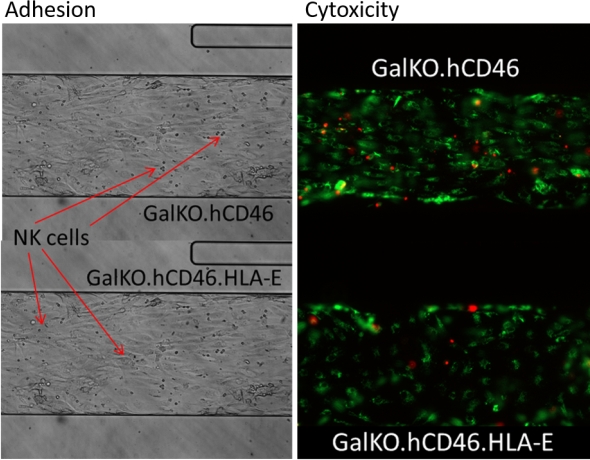Human Leukocyte Antigen-E Expression on Porcine GalTKO.hCD46 Cells Improves Ex-Vivo Xenograft Survival and Attenuates Injury.
1University of Maryland School of Medicine, Baltimore, MD
2Revivicor, Inc, Blacksburg, VA.
Meeting: 2016 American Transplant Congress
Abstract number: 366
Keywords: Xenotransplantation
Session Information
Session Name: Concurrent Session: Xenotransplantation: Animal Models
Session Type: Concurrent Session
Date: Monday, June 13, 2016
Session Time: 4:30pm-6:00pm
 Presentation Time: 5:42pm-5:54pm
Presentation Time: 5:42pm-5:54pm
Location: Room 102
Purpose:
Lung xenografts are subject to injury mechanisms associated with the sequestration of human cells, including natural killer (NK) cells. To control NK cell associated injury, human leukocyte antigen (HLA)-E was added onto the GalTKO.hCD46-pig genetic background. We evaluated the effect of this modification on lung injury patterns and performance.
Methods:
Transgenic pig lungs were perfused with fresh heparinized human blood until failure or elective termination at 4 hrs. Porcine aortic endothelial cells (PAECs) were cultured in monolayers on microfluidic channels through which NK cells were perfused. NK cell adhesion and cytotoxicity were measured using fluorescent dyes and image processing software.
Results:
Median survival time of GalTKO.hCD46 lungs was 162m (range 5-240) whereas all GalTKO.hCD46.HLA-E lungs survived to 4h (p=.012). Pulmonary vascular resistance (PVR) in the HLA-E group was significantly lower during the first 3 hrs (82±13 v 156±26 mmHg-min/L at 150m, p=0.018). Platelet sequestration (36±8 v 82±10 %initial value after 240m, p=0.004), histamine elaboration (36.6±15 v 104±17, [Delta] from initial value at 60m, p=0.007; p=0.068 at 240m), and platelet activation ([Delta]BTG, 505±166 v 1350±133, [Delta] from initial value at 240m, p=0.003) were also significantly lower with HLA-E expression. NK cell and neutrophil sequestration, complement activation, thrombin, and thromboxane generation were similar between groups. In vitro, HLA-E expression did not significantly alter adhesion but significantly reduced antibody-independent cytotoxicity. 
Conclusions:
The addition of the HLA-E transgene is associated with improved PVR and lung survival, without significantly attenuating NK cell sequestration. These data are consistent with the hypothesis that HLA-E expression prevents NK cell activation and cell-mediated cytotoxicity. Future investigation will further evaluate the effect of HLA-E on NK cell adhesion and activation in vitro.
CITATION INFORMATION: Laird C, Kubicki N, Burdorf L, Zhang T, Chang X, Braileanu G, Phelps C, Ayares D, Azimzadeh A, Pierson R. Human Leukocyte Antigen-E Expression on Porcine GalTKO.hCD46 Cells Improves Ex-Vivo Xenograft Survival and Attenuates Injury. Am J Transplant. 2016;16 (suppl 3).
To cite this abstract in AMA style:
Laird C, Kubicki N, Burdorf L, Zhang T, Chang X, Braileanu G, Phelps C, Ayares D, Azimzadeh A, Pierson R. Human Leukocyte Antigen-E Expression on Porcine GalTKO.hCD46 Cells Improves Ex-Vivo Xenograft Survival and Attenuates Injury. [abstract]. Am J Transplant. 2016; 16 (suppl 3). https://atcmeetingabstracts.com/abstract/human-leukocyte-antigen-e-expression-on-porcine-galtko-hcd46-cells-improves-ex-vivo-xenograft-survival-and-attenuates-injury/. Accessed December 25, 2025.« Back to 2016 American Transplant Congress
